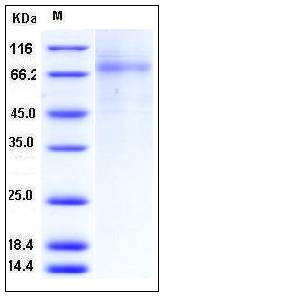Human PLTP Protein (His Tag)
BPIFE,HDLCQ9
- 100ug (NPP4180) Please inquiry
| Catalog Number | P11171-H08H |
|---|---|
| Organism Species | Human |
| Host | Human Cells |
| Synonyms | BPIFE,HDLCQ9 |
| Molecular Weight | The secreted recombinant human PLTP consists of 487 amino acids after removal of the signal peptide and has a predicted molecular mass of 54.5 kDa. As a result of glycosylation, the apparent molecular masss of rh PLTP is approximately 70-80 kDa in SDS-PAGE under reducing conditions. |
| predicted N | Glu 18 |
| SDS-PAGE |  |
| Purity | > 80 % as determined by SDS-PAGE |
| Protein Construction | A DNA sequence encoding the human PLTP isoform 1 (P55058-1) (Met 1-Val 493) was expressed, fused with a polyhistidine tag at the C-terminus. |
| Bio-activity | |
| Research Area | Developmental Biology |Metabolism |Types of disease |Metabolism in Cancer |
| Formulation | Lyophilized from sterile PBS, pH 7.4 1. Normally 5 % - 8 % trehalose, mannitol and 0.01% Tween80 are added as protectants before lyophilization. Specific concentrations are included in the hardcopy of COA. |
| Background | Phospholipid transfer protein, also known as Lipid transfer protein II and PLTP, is a secreted protein which belongs to the BPI/LBP/Plunc superfamily and BPI / LBP family. PLTP is nearly ubiquitously expressed in cells and tissues. PLTP converts HDL into larger and smaller particles. It may play a key role in extracellular phospholipid transport and modulation of hdl particles. High-density lipoproteins (HDL) play a major protective role against the development of coronary artery disease. PLTP is a main factor regulating the size and composition of HDL in the circulation and plays an important role in controlling plasma HDL levels. This is achieved via both the phospholipid transfer activity of PLTP and its capability to cause HDL conversion. PLTP is one of the key lipid transfer proteins in plasma and cerebrospinal fluid. It is involved in novel intracellular functions. PLTP is an important modulator of lipoprotein metabolism, including interparticle phospholipid transfer, remodeling of HDL, cholesterol and phospholipid efflux from peripheral tissues, and the production of hepatic VLDL. PLTP also plays an important role in inflammation and oxidative stress. Accordingly, PLTP has also been implicated in the development of atherosclerosis. |
| Reference |
